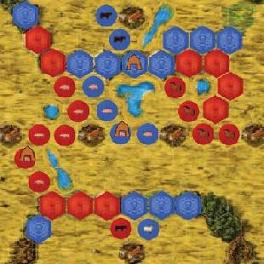When the last card of the animal supply is bought or used to
replace one that is bought, the second stack is activated and becomes the new
animal supply. At the end of this round, after the last player has
completed his turn, the game flow is interrupted for the interim scoring.
When the animal supply is again exhausted, the players finish that round and
then end the game with the final scoring.
Both interim and final scoring run the same way. The players score
points first for markets, then for land chains, then haciendas, then water,
and, finally, for the money that each player has. The players record their
points as they are scored by moving their scoring markers on the scoring track.
To speed the process, players should use the rule summaries.
points for connected markets
Players earn points for each market they are connected to. It does not
matter how many herds are connected to a market or how many market sides
are connected - only the number of markets connected. Players earn the points
in clockwise order using the following table:
| number of connected markets |
1 |
2 |
3 |
4 |
5 |
6 |
7 |
8 |
9 |
10 |
11 |
| points |
1 |
3 |
6 |
10 |
15 |
21 |
28 |
36 |
45 |
55 |
66 |
Example: a player whose herds connect to 7 markets earns 28 points.
points for land chains
Award each player his points in clockwise order. Add up all land
tiles that the player has in chains of at least 3 land tiles in length.
Single land tiles and 2 tile chains are not counted! The points are scored
using the following formula:
number of land tiles times 2 points.
Example: a player has a 7 tile chain and two 3 tile chains. He also
has a 2 tile chain and 3 single tiles, but these are not counted.
Thus, he scores 7 + 3 + 3 = 13 x 2 = 26 points.
points for haciendas
Award each player his points in clockwise order. Sum all the land
tiles that belong to chains with haciendas and all the animal tiles in herds
with haciendas. The points are scored using the following formula:
number of land tiles times 1 point.
Note: if a land chain has more than one hacienda, it only
counts once.
Example: a player has 2 haciendas; one stands on a land chain of 7 land tiles
and the other stands on a herd of 6 animals. Thus, he
earns 7 + 6 = 13
points.
points for water tiles
Players score each water tile separately. For each land tile and animal tile
that is adjacent to a water tile, the owner of the land or animal tile earns 1 point,
regardless of whether the water tile was placed on the board at the beginning of the
game or was placed later. After a water tile has been scored, turn it over.
After the interim scoring, turn these all water-side up again.
points for money
Each player counts his money. For each full 10 pesos, he receives 1 point.
Example: at game end, a player has 28 pesos. Thus, he scores 2
points.
Example for scoring

scoring for red in detail
markets:
red has connected to 5 markets. He has only failed
to reach the market in the upper center. He earns 15 points.
land chains: red has a 4 tile chain upper right and a 3 tile chain
lower left. The sum of 7 land tiles scores red 14 points. The 2 tile
chain upper left does not score.
haciendas: red has a hacienda on a 6 tile pig herd. He earns 6 points.
water tiles: the 1 space water tile on the left earns red 4 points, the 2 space water tile under that earns red 6 points. The 3 space water
tile in the middle earns red 1 point, and the 1 space water tile on the
right earns red 6 points. The animals between two water tiles earn
points for both water tiles.
The two pigs in the middle earn 1
point for each of the water tiles
they touch. Thus, they earn a total of 4 points.
money: red has 12 pesos. This earns him 1 point.
| player |
red |
blue |
| connected markets |
5 |
15 points |
4 |
10 points |
| land chains |
7 (3+4) |
14 points |
10 (7+3) |
20 points |
| haciendas |
6 |
6 points |
7+4 |
11 points |
| water tiles |
4+6+1+6 |
17 points |
7+4 |
11 points |
| money |
12 pesos |
1 points |
8 pesos |
0 points |
| total |
|
53 points |
|
52 points |